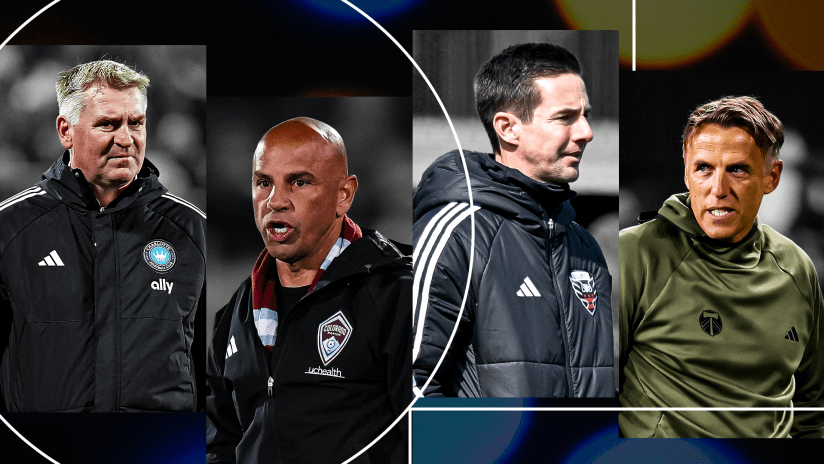Should we be making sweeping conclusions after just two full weekends of MLS games? Nope.
This is the time of year when we hold off on calling our offseason hot takes big successes or big flops because it’s just too early to say much of anything for certain. But have we seen enough to at least start piecing together a few puzzles from around the league? Absolutely.
Looking specifically at teams with new coaches, we now have a sample (albeit a small one) of how they each want to play. Here’s what I’m seeing from those teams so far in 2024.
To clue us in on Charlotte FC’s tactical approach under new manager Dean Smith, I’m going to pass the mic to… new Charlotte manager Dean Smith.
“I can sit here and say my playing philosophy is the same as Pep Guardiola’s or Jurgen Klopp’s, but we haven’t got their players,” Smith said shortly after he was hired in North Carolina. “So my playing style has always been, if we lose the ball, win the ball back quickly and go and score as quickly as we can. And if we can't, then we retain possession and find different ways to score.”
You can’t knock Smith’s honesty or his accuracy.
That quote nails how Charlotte FC have approached things in their first two games of 2024 – and how they differ from Christian Lattanzio’s version of Charlotte FC in 2023. Where Lattanzio put together detailed possession rotations and tried to commit to short passing, Smith is leaning into transition. Against New York City FC at home and Vancouver on the road, Charlotte used a 4-2-3-1, fought hard on attacking set pieces, and hit quickly in transition.
Smith and Charlotte haven’t shown much in possession this year. But to be fair, they haven’t needed to. This team has the bones to be dangerous once their new DPs arrive.

Colorado's first two games of 2024 have been downright weird.
Chris Armas’ team started the year off with a 4-1 loss at Providence Park against the Portland Timbers, where the Timbers jumped out so far ahead so early in the match that we didn’t get a great look at the Rapids’ preferred gameplan. Then in Saturday's 1-1 draw, the Rapids were stuck playing against a Nashville team that was even more defensive than normal thanks to the absence of their two attacking DPs.
Because of the game state against Portland and the fact Gary Smith loves himself a low block, we haven’t gotten to see a “normal” game from Colorado so far. Here’s what we do know, though:
- Armas wants to use a 4-2-3-1 in possession with Djordje Mihailovic as the No. 10
- Armas wants to use a 4-4-2 in defense
- Armas isn’t here to play full-on Red Bull ball
That last point is the most interesting one. The Rapids have been more patient with the ball, even factoring in a set of defensive opponents, than I expected. Their passing tendencies are worth monitoring going forward.

It’s been a fun ride through two games for D.C. United fans. After smashing the 10-man New England Revolution to open the campaign, Troy Lesesne’s team earned a 2-2 draw away to the Portland Timbers on Saturday in the new manager’s first official game on the sidelines.
The former New Mexico United and New York Red Bulls coach has brought up-tempo, aggressive soccer to the nation’s capital. According to Opta, D.C. are the most intense pressing team in all of MLS this year, averaging a defensive intervention for every 6.9 passes from the opposition in the middle and final thirds of the field. D.C. United won’t keep up that high press forever, but all signs point to them being one of the most vertical teams in the East with and without the ball.
Positionally, Lesesne has used a 4-2-3-1 shape that can look an awful lot like a 4-3-3 as Mateusz Klich pushes up out of midfield. Top-end talent outside of Christian Benteke is still a real concern, but the existing players are clearly responding well to Lesesne’s new approach. In fact, it’s that direct approach that can transform average attacking contributors into above-average ones by getting them into open spaces more often.
Even through two games, it’s incredibly easy to see new manager Laurent Courtois’ ideas start to take hold with CF Montréal.
The big changes have come with the ball, where Montréal now default to a 3-4-3 shape with principles that mirror some of what Wilfried Nancy and the Columbus Crew do in possession. Stuck on a six-game road trip to start the year, Courtois has maintained some pragmatism with his attacking gameplan – he’s not opening up games for 90 minutes at a time. But the general ideas are clear. Montréal want to build with short passes from the back, find their attacking midfield-types in the halfspaces, and send their speedy wingbacks in behind.
I worry the structure, which seems to be coming along nicely, won’t be quite enough to turn CF Montréal’s pieces into a real threat out East. Still, with a pinch of smart defending, 2024 has started out fine for Courtois and Co. with four points in their pockets.
Not a lot has changed from last year to this one for New England. That was always the most likely on-field outcome when Caleb Porter took over ahead of this 2024 season.
Last year, the Revs mostly used a 4-2-3-1. In the past, Porter has mostly used a 4-2-3-1. Last year, the Revs didn’t push hard towards any specific tactical approach, instead hanging out somewhere in the middle between possession and transition and pressing and low-block defending. Those same tendencies mostly apply to Porter, too.
So while Giacomo Vrioni’s early pair of yellow cards against D.C. in New England’s season opener tainted the sample, the early signs all point to Porter’s Revs looking a lot like past versions of this team. They’ll take the ball if you give it to them, they’ll play through Carles Gil, and they’ll avoid going all-out defensively.
Porter may want to add a few wrinkles to this group, but getting an actual striker back on the field is a bigger priority.

The Red Bulls have found themselves something in 21-year-old Swedish center back Noah Eile. Signed as a U22 Initiative player during the offseason, Eile, along with star attacking midfielder Emil Forsberg, is giving new manager Sandro Schwarz another weapon in his tactical arsenal. With delightful line-breaking passes from the middle of the backline, Eile is busting defenses with finesse.
The 45-year-old German coach still has his team pressing high up the field in a 4-4-2 or a 4-2-2-2 shape. But with Eile’s distribution and Forsberg’s quality between the lines, the Red Bulls are infinitely more capable of causing opposing defenses problems with their possession play than they were at any point in 2023. That’s an incredibly encouraging development for a team that lacked talent and tactical diversity in key areas before the Swedish reinforcements arrived.
Schwarz has a fun, multi-faceted team on his hands.

Like Porter, Phil Neville was never going to usher in a completely new tactical setup in Portland.
There’s been a ton of overlap between Gio Savarese’s go-to look with the Timbers from the past and Neville’s current 4-2-3-1, transition-focused system. Even without a single minute being played by a DP this year, Portland have shown a real threat on the ball. Eryk Williamson has been excellent as a box-arriving No. 10 while filling in for Evander and the right side of Juan Mosquera and Santi Moreno looks dangerous in open space.
The Timbers have been the second-most direct attacking team in MLS so far this year, moving the ball towards goal at a rate of 2.66 meters per second, according to Opta. They were second in that same direct speed metric last year, too.
When the DPs arrive (or get healthy, in Evander’s case), Neville will have the chance to diversify his system. But don’t expect too many changes in Portland.

Ever the wildcard, John Herdman has used a 3-4-3 shape with Federico Bernardeschi playing as a right wingback in both of Toronto FC’s 2024 matches. We certainly didn’t see that look from Toronto in Herdman’s one game on the sidelines last year.
With Bernardeschi inverted on the right and Lorenzo Insigne playing in his classic left halfspace role, the Italians have looked more engaged than they did at any point last season. Deybi Flores continues to clean up messes as half of the midfield double pivot, easing the defensive burden on the two attacking DPs.
At the moment, it seems like there’s very little reason to change things up in Toronto. They haven’t been world-beaters this year – and they likely won’t be at any point this season – but a steady system and interested Italians will be TFC’s ticket to relevance in the Eastern Conference this year.
















